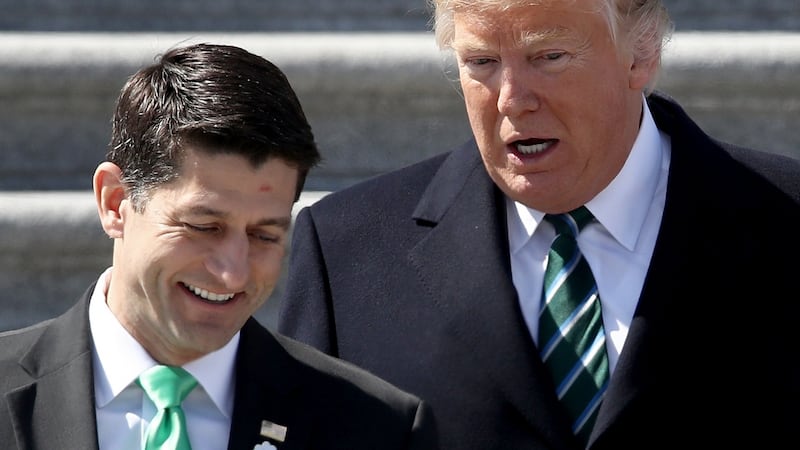Irish Americans figure prominently among President Donald Trump’s advisers, as they do among Republican leaders and (now former) Fox News hosts. Does it follow, as some surmise, that Irish America has moved sharply to the right and provides a strong base of support for conservative policies and Republican politics?
How do Irish Americans vote? Do they even constitute a distinct block of voters? The simple answer is we do not know; at least, we do not have sufficient, reliable data on which to make sound judgments. This is of a piece with our lack of knowledge about Irish America more generally.
The last US census, in 2010, recorded 34.7 million Americans of Irish heritage. But it is unclear if those ticking the Irish box are indicating a core sense of identity, some vague if strongly felt affinity, or something else. Such ambiguity goes to the heart of the difficulty in defining or measuring diaspora identity.
The Clinton Institute at University College Dublin is currently researching contemporary Irish America to provide details that may allow us to answer some of these beguiling questions about identity. Already, the research is throwing up some detail on the political and social values of Irish America.
Late ethnicity
Irish America is at a stage of “late ethnicity” or “late generation ethnicity” – terms used by sociologists to indicate an ethnic formation that reaches back many generations in the US and is not being replenished from the country of origin.

For some, Irish America is not so much “late” as deceased, assimilated to a point of irrelevance as an ethnic identity. But declarations of the death of Irish America have been made before and they have proved premature.
In 1963, for example, the Irish American politician Daniel Moynihan remarked on a terminal decline of Irish America, but by the mid-1970s he was predicting the emergence of a “new consciousness of Irishness” in the US.
Political perspectives trended broadly towards Democrat/liberal. In the 2016 presidential election, 47 per cent voted for Clinton
Irish America was re-energised in the context of the broader ethnic revivalism of the 1970s, a phenomenon of socio-political capitalisation that sought to distinguish and celebrate white ethnicity in the wake of the Civil Rights Movement.
The paradox of this moment is important to understanding the trajectory of Irish America in the past 50 years, as an ethnic group that had “made it” in America at the same time as it appeared to lose its ethnic specificity.
As Irish American priest and sociologist Andrew Greeley asked somewhat poignantly in 1972: “What happens to a group which, having invested all its resources and energies into making it finally succeeds? In other words, what do you do for an encore?”
The answer is you invest in the symbolic ethnicity of your group, endorse the values of individualism and choice that this investment psychologically underwrites, and enjoy the relative comforts of late ethnicity. Which begs the question: is growing conservatism the consequence of having “made it”?
Trending towards Democrat
The research conducted by the Clinton Institute and partners in recent months has several strands and utilises both online surveys and fieldwork.
One strand of this research (in collaboration with Glucksman Ireland House at New York University) involved a survey of users of the Irish Central website, the largest and most prominent Irish American website in the US.
In February of this year, 3,181 subscribers to the site responded to the survey. We found that 51 per cent of the respondents were third generation and beyond, and that their levels of education and income are well above the American medians – all of which reinforces the late ethnicity perception of this ethnic grouping.
Political perspectives trended broadly towards Democrat/liberal. In the 2016 presidential election, 92 per cent of respondents voted: 47 per cent voted for Clinton, 27 per cent for Trump, and 20 per cent refused to indicate their vote. More generally, 41 per cent signified as Democrat while 23 per cent selected Republican. The preferred news sources were more liberal than conservative; for example, of those who got their news from television, 45 per cent used NBC while 36 per cent used Fox.
The Irish, historically a powerful presence in Chicago's leadership via their control of the "Democratic machine", remain potent in today's politics
On immigration, signals were notably mixed, with 68 per cent in favour of immigration reform to support the undocumented Irish in the US, while 40 per cent wanted tougher restrictions on immigrants to America. This is a response that perhaps speaks to the paradox noted above that accentuates tensions in Irish American perceptions of immigration.
As with all such surveys, the data is skewed by a variety of factors. The largest concentration of respondents were from three states with strong Democratic presence, New York, Massachussetts and California. That noted, the survey is nonetheless suggestive of a large residual support for the Democratic Party among Irish Americans despite much anecdotal evidence to the contrary.
Irish Chicago
This data is valuable in helping us to determine some basic demographics of contemporary Irish America. It can be a challenge though with such data to interpret social and political values and biases.
More recently, we have conducted extensive fieldwork in Chicago to study Irish American networks, organisations, and communities. In this instance (in collaboration with Dominican University), a similar survey has been used but now supplemented with interviews of individuals and focus groups from a wide spectrum of Irish Chicagoans.
Politically, Chicago remains a staunchly Democrat city. In November, Chicagoans voted 83.7 per cent in favour of Clinton, and the city has taken on a leading role as a “sanctuary city” in recent months, pushing back against the Trump administrations actions on immigration.
The Irish, historically a powerful presence in the city’s leadership via their control of the “Democratic machine”, remain potent in today’s politics, despite the significant movement of Irish Chicagoans into the suburbs over the past 50 years.
This is not to report that Irish Chicago is a homogenous bastion of left-liberal values. While voting Democrat remains a relatively stable factor, we encountered a broad range of social and political opinion among our Irish interviewees, and also noted some significant differences between longer settled and newer emigrants.
A Chicago politician described new Irish emigrants as “astonishingly progressive” compared to the longer resident diaspora – a view that echoed the Irish Central survey where Irish American respondents thought Ireland “more liberal” than the US. Notably, the strong Irish presence in the immigration reform movement in Chicago and Illinois is led by Irish-born emigrants.
President Trump's advisers do not represent the sum of Irish America
The election of president Trump very much coloured the period of our research in Chicago. There was particular apprehension expressed by and about undocumented Irish, a concern that they have become more vulnerable due to the executive orders passed by Trump.
Some of the undocumented expressed anxiety about becoming stigmatised within the Irish community in the city.
Get in shape
Based on these findings, President Trump’s advisers do not represent the sum of Irish America. They do however represent an ascendant nativism in the US that is challenging the sureties of ethnic and racial allegiances. Whither Irish America in this new dispensation of national identity politics?

When I posed this question to a veteran Irish American alderman in Chicago, he answered: “Being Irish American has become a benefit to the Irish. In the past being Irish American was something you had to overcome . . . You don’t have to stay in shape if you’re not going to fight anybody.”
That’s the thing about late ethnicity: you can become paunchy. Maybe Irish America needs to get back in shape.
Liam Kennedy is director of the Clinton Institute for American Studies at University College Dublin


















